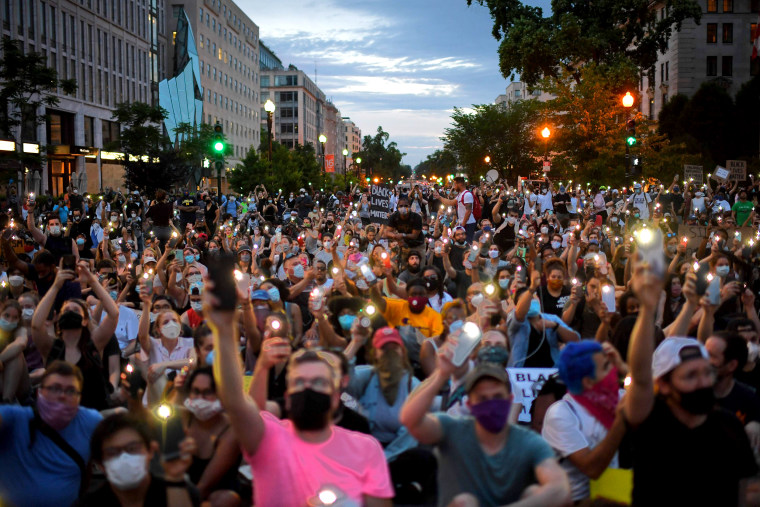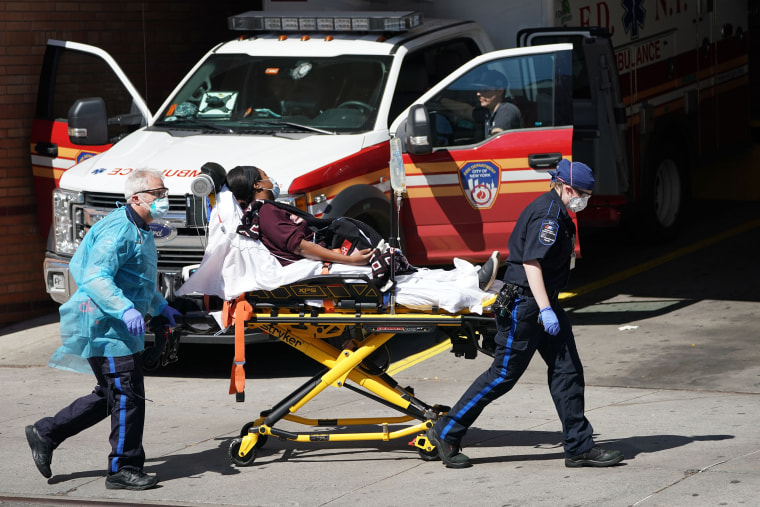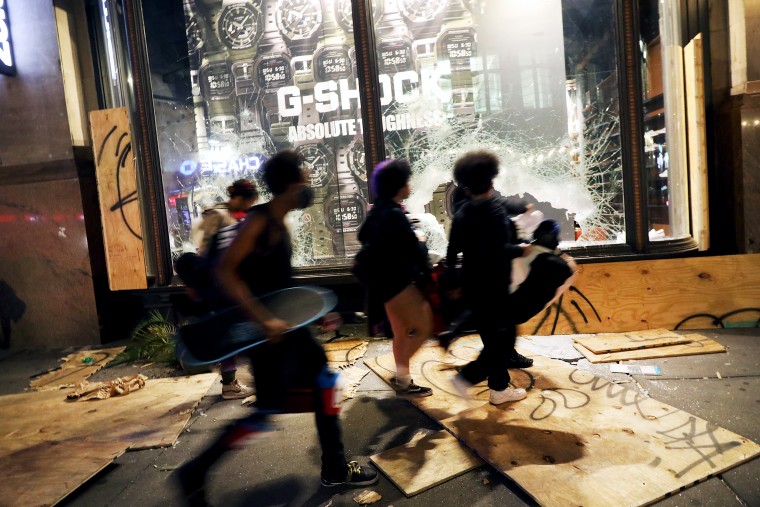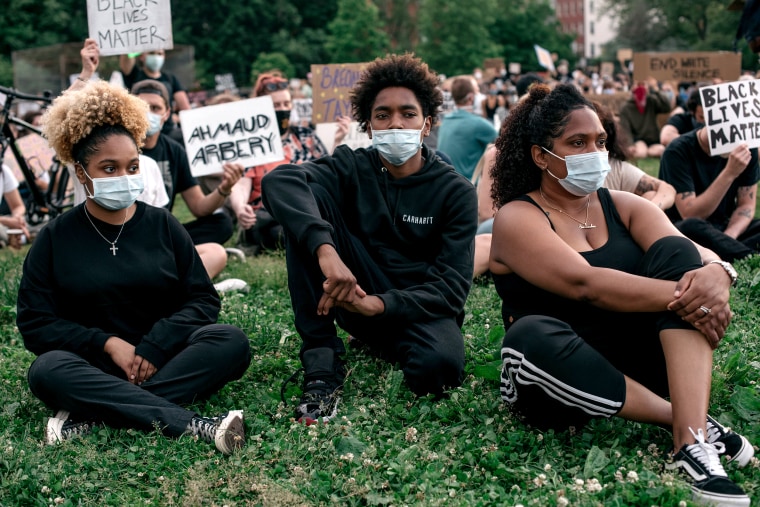At a police brutality protest attended by thousands in Manhattan this week, a young black man couldn't help but make an observation — the size and scale of the protests following George Floyd's death would not be possible had it not been for the once-in-a-lifetime global health and economic crises.
"I think there's a bunch of people here that are obviously for this cause," the man, who gave his name as Adio, told NBC News. "But I think ultimately, we've been locked in our apartments for so long that now we have something to unite us that is actually uplifting...We've all needed a reason to step outside our house, and this is it."
With roughly 40 million people out of work in the U.S, and schools and activities shut down with a preceding three months that for many meant near total lockdown of their lives in New York City and elsewhere, the protests have been able to gain incredible momentum, especially among young people.

"Young people I think sometimes feel like they can just limit their activism to social media and that’s enough,” said Kenny Moore, 21, a student from Maryland, protesting in Washington, D.C. on Tuesday. "But now it's like there's no excuse cause we're all at home."
Other young protesters expressed similar sentiment.
"It's been weird being out of school," said Christiana Laguerre, a college student at Towson University in Maryland. "Everyone's at home and honestly it feels really good to just be around people again. We all have more time on our hands and really don't have an excuse to not show up."
Alondra Pacheco, 20 and unemployed, said, "Everyone is at home with not much to do. It's like the perfect storm."
A "perfect storm" was similarly how New York City Mayor Bill de Blasio, a Democrat, described the confluence of crises that have helped widen the peaceful protests and, in his city and elsewhere, contributed to some degree to rioting and looting. While some officials have pinned vandalism and violence on extremist groups at both ends of the political spectrum, others said they believe some of it is driven by thrill-seeking young people who finally have an outlet as the weather improves and virus fears subside.
"We have not seen a situation like this," de Blasio said of what he described as "a horrible perfect storm we're living through" at press conference earlier this week. "And it's literally because of very particular dynamics that have come together."
As New York Gov. Andrew Cuomo, a Democrat, told MSNBC on Monday: "There are forces coming together here, let's be honest."
"It's not a coincidence that this is in the middle of the COVID crisis," Cuomo continued. "The poor paid the highest price for this COVID situation."
Lynn Bufka, the associate executive director for practice research and policy at the American Psychological Association, told NBC News that while there is no current research linking the intersection of the multiple crises, she has anecdotal evidence that "young people in particular are struggling, despite general familiarity and comfort with technology in this generation that many had presumed would help them stay connected while distancing."
"To gather in protest means to gather with others who share your grief, your anger, your fear, your frustration, your demand for change," she said. "That can be incredibly uplifting and restorative and psychologically and emotionally healing."
The virus itself has wreaked havoc on black and brown communities, both on the health and economic side. The latest data from the Bureau of Labor Statistics showed that fewer than half of black workers were employed in April.
As Georgetown Law professor Lawrence Gostin, an expert in public health law, told NBC News, the pandemic "has exacerbated protests against racial injustice nationwide."
"George Floyd's death was the spark, but the COVID-19 epidemic is at the foundation of today's grievances," Gostin said. "COVID-19 has shined a spotlight on racial injustice in America in the most profound ways. The COVID-19 epidemic has caused tens of thousands of preventable deaths in the African American community. Racial inequalities in health have been with us for decades, but COVID-19 has amplified the inequities."

Elwood Watson, a professor of history and African American studies at East Tennessee State University, said the pandemic has "tremendously" affected the demonstrations, pointing to its outsized impact on communities of color.
As states remain at an early or mid stage of their reopening processes, much attention has been paid to the demonstrations, with videos of law enforcement crackdowns as well as images and pushback to rioting going viral. A Monmouth University poll released this week asked respondents if they think "racial and ethnic discrimination in the U.S. is a problem or not a problem?"
In January 2015, when the polling outlet first asked the question as the Black Lives Matter movement gained traction, 51 percent said that was a "big problem." This week, that number spiked to 76 percent after the nation was exposed to the Floyd video and the all-encompassing attention given to the subsequent demonstrations.
"This time it's different," Sen. Marco Rubio, R-Fla., tweeted Thursday.
On the other hand, officials have worried about whether the protests will lead to a resurgence in the virus after spending months to keep it curtailed. Fears over the further spread of the novel coronavirus have been drowned out in the protests, as Rep. Eleanor Holmes Norton, D-D.C., expressed concern over to NBC News.
Holmes Norton said the confluence of the coronavirus and the economic collapse has fueled a "new energy" from young people in protesting longstanding issues between police and the communities they serve, and the Floyd video has proven too severe for many to ignore.

Of looting and vandalism, Holmes Norton said that while "we almost always see some looting in such situations like this," it's exacerbated now by young people being out of work.
"So there's some inherent vandalism in a situation of this kind," she said. "But I think it's driven even more by the fact that people have not only been at home, they've been at home out of work."
At Tuesday's protest in the nation's capitol, Ashley Waite, a 22-year-old hairstylist from Miami, told NBC News that she returned home to be with her family when her hair salon shut down. She's "feeling the energy" of the demonstrations, which she said would not be going on in this way had people not been stuck at home for months.
"I follow a lot of my customers and coworkers and stuff on Instagram," she said, "and I see them all out doing stuff, too, and I'm not sure that would've been the case if we all didn't have this time on our hands."
Allan Smith reported from New York and Lauren Egan reported from Washington.


